International Marketing Report: Analyzing Rapha's Global Strategies
VerifiedAdded on 2021/01/01
|22
|6503
|79
Report
AI Summary
This report provides a comprehensive analysis of international marketing strategies, focusing on the case of Rapha Performance Roadwear, a cycling apparel and accessories brand. The report explores the scope and key concepts of international marketing, examining topics such as exports, contractual agreements, joint ventures, and mergers. It identifies Brussels, Belgium, as a potential market for expansion and suggests joint venturing as a suitable entry strategy. The report delves into the rationale for Rapha's international expansion, highlighting the benefits of increased economies of scale, market share, and innovation. It also outlines various market entry modes, including website sales, direct sales, and partnerships with distributors, alongside the challenges and opportunities presented by the international environment, such as political factors, flexibility, and globalization. Furthermore, the report discusses the key arguments in the global versus local debate, explores how marketing elements like product, price, and promotion differ internationally, and compares home versus international orientation approaches. The report concludes by assessing Rapha's international marketing approaches, providing insights into how the company can successfully navigate the complexities of global markets.

INTERNATIONAL
MARKETING
MARKETING
Paraphrase This Document
Need a fresh take? Get an instant paraphrase of this document with our AI Paraphraser
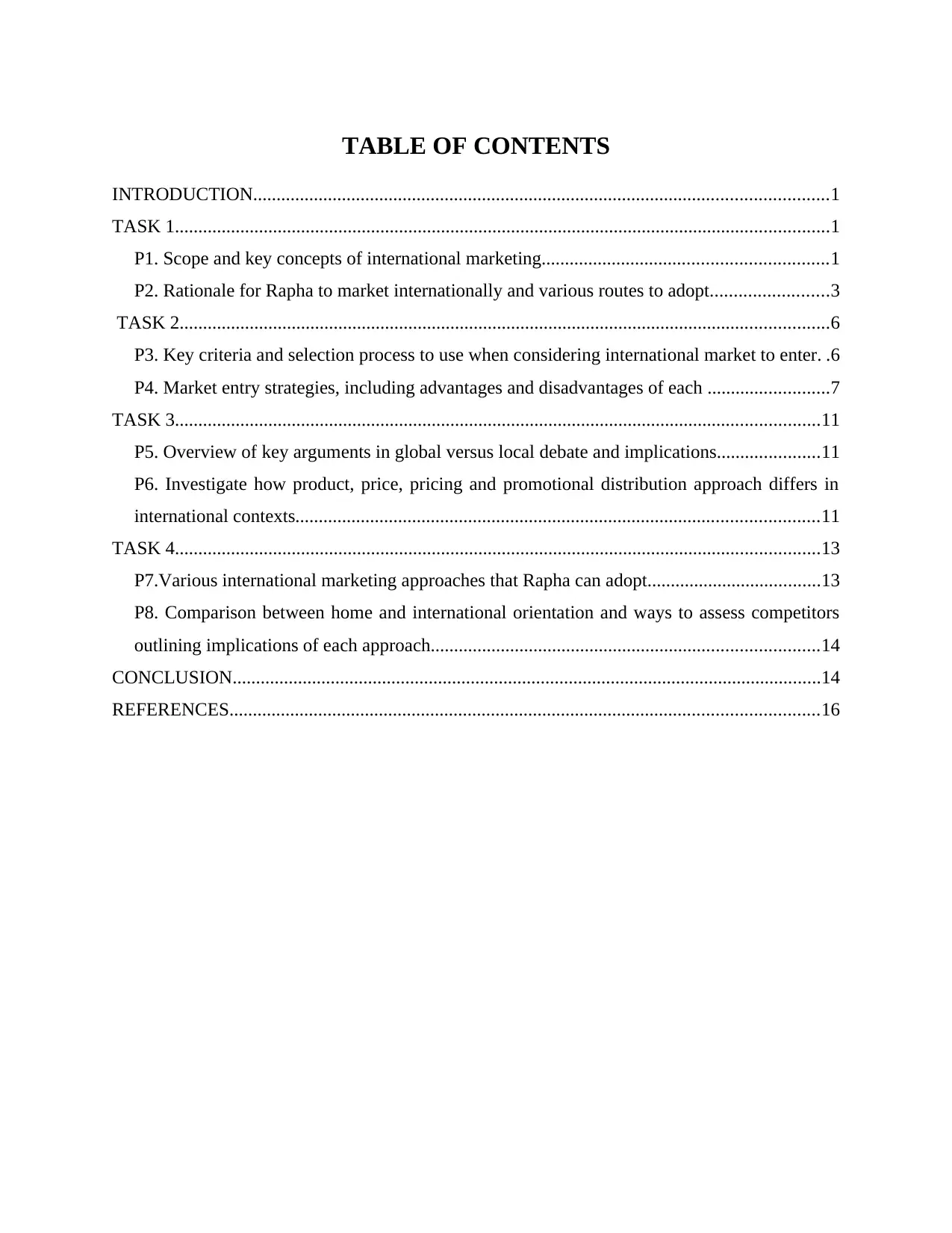
TABLE OF CONTENTS
INTRODUCTION...........................................................................................................................1
TASK 1............................................................................................................................................1
P1. Scope and key concepts of international marketing.............................................................1
P2. Rationale for Rapha to market internationally and various routes to adopt.........................3
TASK 2...........................................................................................................................................6
P3. Key criteria and selection process to use when considering international market to enter. .6
P4. Market entry strategies, including advantages and disadvantages of each ..........................7
TASK 3..........................................................................................................................................11
P5. Overview of key arguments in global versus local debate and implications......................11
P6. Investigate how product, price, pricing and promotional distribution approach differs in
international contexts................................................................................................................11
TASK 4..........................................................................................................................................13
P7.Various international marketing approaches that Rapha can adopt.....................................13
P8. Comparison between home and international orientation and ways to assess competitors
outlining implications of each approach...................................................................................14
CONCLUSION..............................................................................................................................14
REFERENCES..............................................................................................................................16
INTRODUCTION...........................................................................................................................1
TASK 1............................................................................................................................................1
P1. Scope and key concepts of international marketing.............................................................1
P2. Rationale for Rapha to market internationally and various routes to adopt.........................3
TASK 2...........................................................................................................................................6
P3. Key criteria and selection process to use when considering international market to enter. .6
P4. Market entry strategies, including advantages and disadvantages of each ..........................7
TASK 3..........................................................................................................................................11
P5. Overview of key arguments in global versus local debate and implications......................11
P6. Investigate how product, price, pricing and promotional distribution approach differs in
international contexts................................................................................................................11
TASK 4..........................................................................................................................................13
P7.Various international marketing approaches that Rapha can adopt.....................................13
P8. Comparison between home and international orientation and ways to assess competitors
outlining implications of each approach...................................................................................14
CONCLUSION..............................................................................................................................14
REFERENCES..............................................................................................................................16
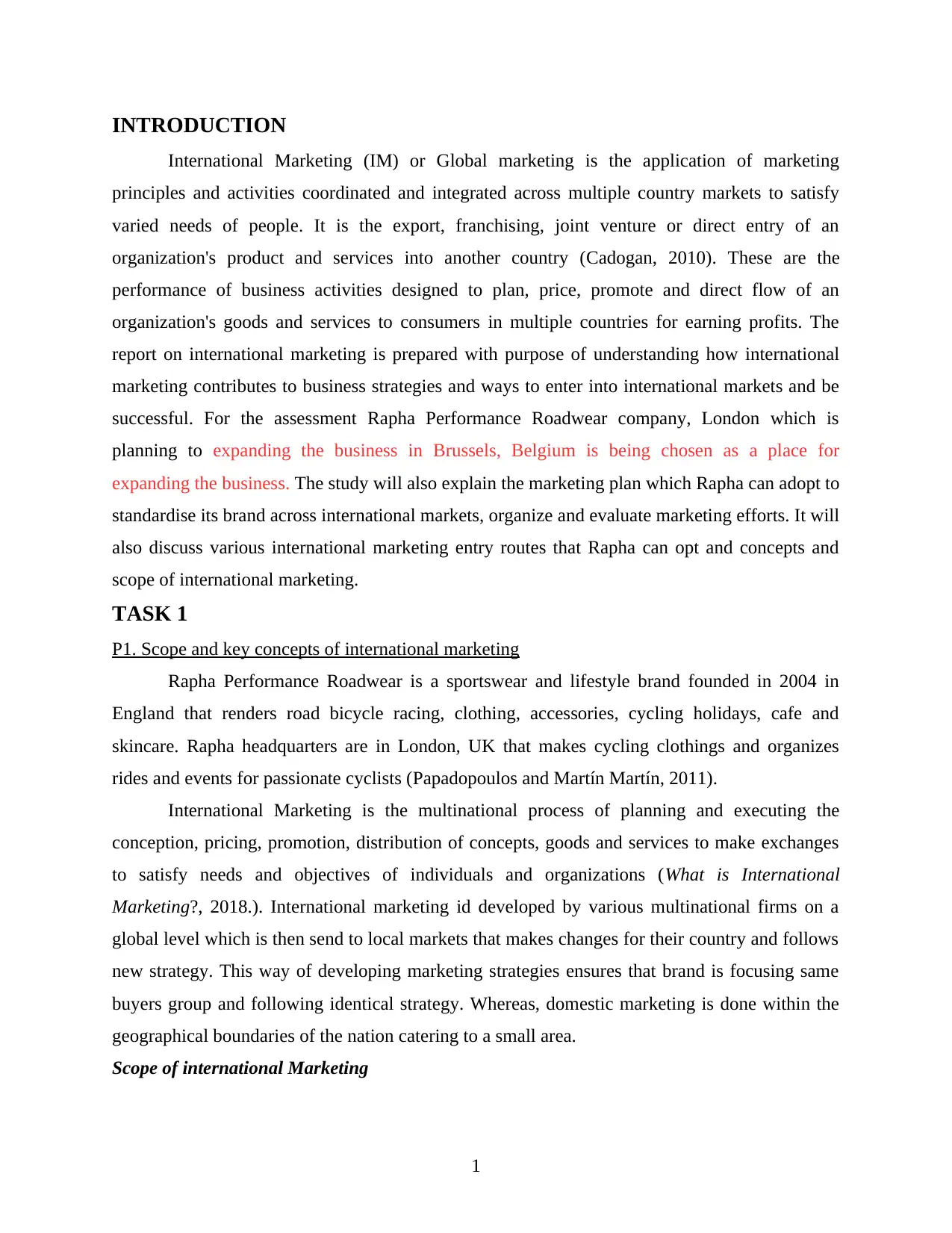
INTRODUCTION
International Marketing (IM) or Global marketing is the application of marketing
principles and activities coordinated and integrated across multiple country markets to satisfy
varied needs of people. It is the export, franchising, joint venture or direct entry of an
organization's product and services into another country (Cadogan, 2010). These are the
performance of business activities designed to plan, price, promote and direct flow of an
organization's goods and services to consumers in multiple countries for earning profits. The
report on international marketing is prepared with purpose of understanding how international
marketing contributes to business strategies and ways to enter into international markets and be
successful. For the assessment Rapha Performance Roadwear company, London which is
planning to expanding the business in Brussels, Belgium is being chosen as a place for
expanding the business. The study will also explain the marketing plan which Rapha can adopt to
standardise its brand across international markets, organize and evaluate marketing efforts. It will
also discuss various international marketing entry routes that Rapha can opt and concepts and
scope of international marketing.
TASK 1
P1. Scope and key concepts of international marketing
Rapha Performance Roadwear is a sportswear and lifestyle brand founded in 2004 in
England that renders road bicycle racing, clothing, accessories, cycling holidays, cafe and
skincare. Rapha headquarters are in London, UK that makes cycling clothings and organizes
rides and events for passionate cyclists (Papadopoulos and Martín Martín, 2011).
International Marketing is the multinational process of planning and executing the
conception, pricing, promotion, distribution of concepts, goods and services to make exchanges
to satisfy needs and objectives of individuals and organizations (What is International
Marketing?, 2018.). International marketing id developed by various multinational firms on a
global level which is then send to local markets that makes changes for their country and follows
new strategy. This way of developing marketing strategies ensures that brand is focusing same
buyers group and following identical strategy. Whereas, domestic marketing is done within the
geographical boundaries of the nation catering to a small area.
Scope of international Marketing
1
International Marketing (IM) or Global marketing is the application of marketing
principles and activities coordinated and integrated across multiple country markets to satisfy
varied needs of people. It is the export, franchising, joint venture or direct entry of an
organization's product and services into another country (Cadogan, 2010). These are the
performance of business activities designed to plan, price, promote and direct flow of an
organization's goods and services to consumers in multiple countries for earning profits. The
report on international marketing is prepared with purpose of understanding how international
marketing contributes to business strategies and ways to enter into international markets and be
successful. For the assessment Rapha Performance Roadwear company, London which is
planning to expanding the business in Brussels, Belgium is being chosen as a place for
expanding the business. The study will also explain the marketing plan which Rapha can adopt to
standardise its brand across international markets, organize and evaluate marketing efforts. It will
also discuss various international marketing entry routes that Rapha can opt and concepts and
scope of international marketing.
TASK 1
P1. Scope and key concepts of international marketing
Rapha Performance Roadwear is a sportswear and lifestyle brand founded in 2004 in
England that renders road bicycle racing, clothing, accessories, cycling holidays, cafe and
skincare. Rapha headquarters are in London, UK that makes cycling clothings and organizes
rides and events for passionate cyclists (Papadopoulos and Martín Martín, 2011).
International Marketing is the multinational process of planning and executing the
conception, pricing, promotion, distribution of concepts, goods and services to make exchanges
to satisfy needs and objectives of individuals and organizations (What is International
Marketing?, 2018.). International marketing id developed by various multinational firms on a
global level which is then send to local markets that makes changes for their country and follows
new strategy. This way of developing marketing strategies ensures that brand is focusing same
buyers group and following identical strategy. Whereas, domestic marketing is done within the
geographical boundaries of the nation catering to a small area.
Scope of international Marketing
1
⊘ This is a preview!⊘
Do you want full access?
Subscribe today to unlock all pages.

Trusted by 1+ million students worldwide
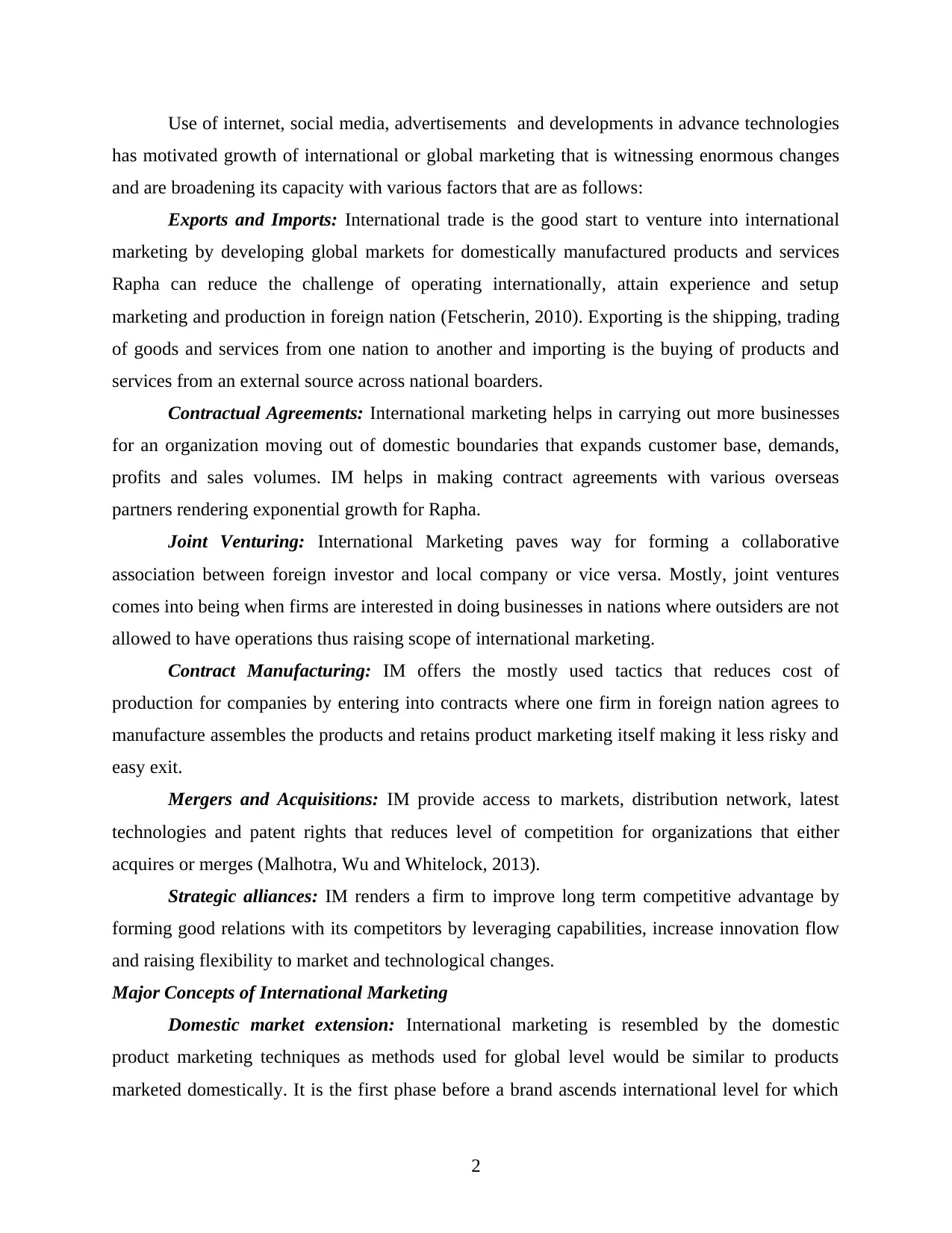
Use of internet, social media, advertisements and developments in advance technologies
has motivated growth of international or global marketing that is witnessing enormous changes
and are broadening its capacity with various factors that are as follows:
Exports and Imports: International trade is the good start to venture into international
marketing by developing global markets for domestically manufactured products and services
Rapha can reduce the challenge of operating internationally, attain experience and setup
marketing and production in foreign nation (Fetscherin, 2010). Exporting is the shipping, trading
of goods and services from one nation to another and importing is the buying of products and
services from an external source across national boarders.
Contractual Agreements: International marketing helps in carrying out more businesses
for an organization moving out of domestic boundaries that expands customer base, demands,
profits and sales volumes. IM helps in making contract agreements with various overseas
partners rendering exponential growth for Rapha.
Joint Venturing: International Marketing paves way for forming a collaborative
association between foreign investor and local company or vice versa. Mostly, joint ventures
comes into being when firms are interested in doing businesses in nations where outsiders are not
allowed to have operations thus raising scope of international marketing.
Contract Manufacturing: IM offers the mostly used tactics that reduces cost of
production for companies by entering into contracts where one firm in foreign nation agrees to
manufacture assembles the products and retains product marketing itself making it less risky and
easy exit.
Mergers and Acquisitions: IM provide access to markets, distribution network, latest
technologies and patent rights that reduces level of competition for organizations that either
acquires or merges (Malhotra, Wu and Whitelock, 2013).
Strategic alliances: IM renders a firm to improve long term competitive advantage by
forming good relations with its competitors by leveraging capabilities, increase innovation flow
and raising flexibility to market and technological changes.
Major Concepts of International Marketing
Domestic market extension: International marketing is resembled by the domestic
product marketing techniques as methods used for global level would be similar to products
marketed domestically. It is the first phase before a brand ascends international level for which
2
has motivated growth of international or global marketing that is witnessing enormous changes
and are broadening its capacity with various factors that are as follows:
Exports and Imports: International trade is the good start to venture into international
marketing by developing global markets for domestically manufactured products and services
Rapha can reduce the challenge of operating internationally, attain experience and setup
marketing and production in foreign nation (Fetscherin, 2010). Exporting is the shipping, trading
of goods and services from one nation to another and importing is the buying of products and
services from an external source across national boarders.
Contractual Agreements: International marketing helps in carrying out more businesses
for an organization moving out of domestic boundaries that expands customer base, demands,
profits and sales volumes. IM helps in making contract agreements with various overseas
partners rendering exponential growth for Rapha.
Joint Venturing: International Marketing paves way for forming a collaborative
association between foreign investor and local company or vice versa. Mostly, joint ventures
comes into being when firms are interested in doing businesses in nations where outsiders are not
allowed to have operations thus raising scope of international marketing.
Contract Manufacturing: IM offers the mostly used tactics that reduces cost of
production for companies by entering into contracts where one firm in foreign nation agrees to
manufacture assembles the products and retains product marketing itself making it less risky and
easy exit.
Mergers and Acquisitions: IM provide access to markets, distribution network, latest
technologies and patent rights that reduces level of competition for organizations that either
acquires or merges (Malhotra, Wu and Whitelock, 2013).
Strategic alliances: IM renders a firm to improve long term competitive advantage by
forming good relations with its competitors by leveraging capabilities, increase innovation flow
and raising flexibility to market and technological changes.
Major Concepts of International Marketing
Domestic market extension: International marketing is resembled by the domestic
product marketing techniques as methods used for global level would be similar to products
marketed domestically. It is the first phase before a brand ascends international level for which
2
Paraphrase This Document
Need a fresh take? Get an instant paraphrase of this document with our AI Paraphraser
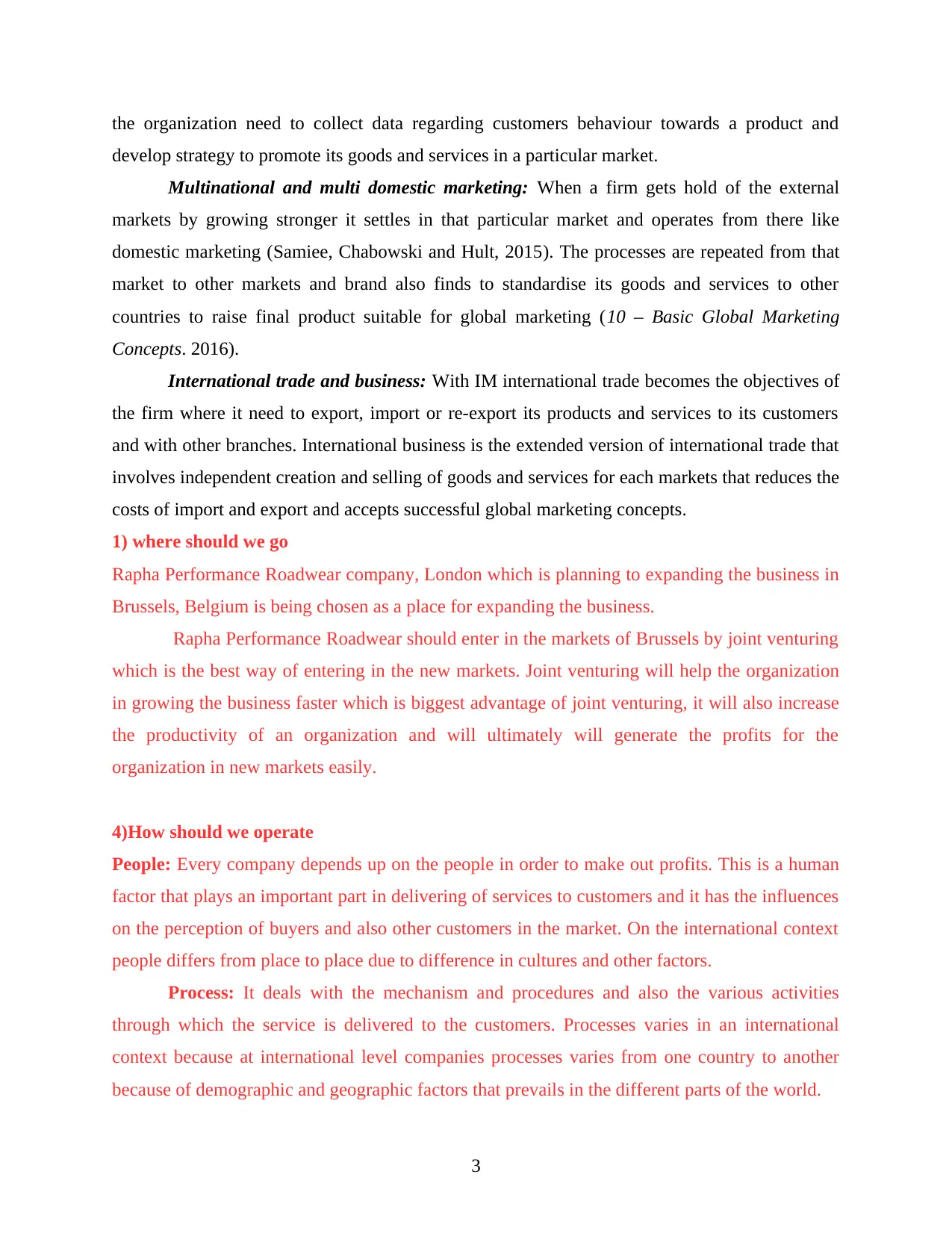
the organization need to collect data regarding customers behaviour towards a product and
develop strategy to promote its goods and services in a particular market.
Multinational and multi domestic marketing: When a firm gets hold of the external
markets by growing stronger it settles in that particular market and operates from there like
domestic marketing (Samiee, Chabowski and Hult, 2015). The processes are repeated from that
market to other markets and brand also finds to standardise its goods and services to other
countries to raise final product suitable for global marketing (10 – Basic Global Marketing
Concepts. 2016).
International trade and business: With IM international trade becomes the objectives of
the firm where it need to export, import or re-export its products and services to its customers
and with other branches. International business is the extended version of international trade that
involves independent creation and selling of goods and services for each markets that reduces the
costs of import and export and accepts successful global marketing concepts.
1) where should we go
Rapha Performance Roadwear company, London which is planning to expanding the business in
Brussels, Belgium is being chosen as a place for expanding the business.
Rapha Performance Roadwear should enter in the markets of Brussels by joint venturing
which is the best way of entering in the new markets. Joint venturing will help the organization
in growing the business faster which is biggest advantage of joint venturing, it will also increase
the productivity of an organization and will ultimately will generate the profits for the
organization in new markets easily.
4)How should we operate
People: Every company depends up on the people in order to make out profits. This is a human
factor that plays an important part in delivering of services to customers and it has the influences
on the perception of buyers and also other customers in the market. On the international context
people differs from place to place due to difference in cultures and other factors.
Process: It deals with the mechanism and procedures and also the various activities
through which the service is delivered to the customers. Processes varies in an international
context because at international level companies processes varies from one country to another
because of demographic and geographic factors that prevails in the different parts of the world.
3
develop strategy to promote its goods and services in a particular market.
Multinational and multi domestic marketing: When a firm gets hold of the external
markets by growing stronger it settles in that particular market and operates from there like
domestic marketing (Samiee, Chabowski and Hult, 2015). The processes are repeated from that
market to other markets and brand also finds to standardise its goods and services to other
countries to raise final product suitable for global marketing (10 – Basic Global Marketing
Concepts. 2016).
International trade and business: With IM international trade becomes the objectives of
the firm where it need to export, import or re-export its products and services to its customers
and with other branches. International business is the extended version of international trade that
involves independent creation and selling of goods and services for each markets that reduces the
costs of import and export and accepts successful global marketing concepts.
1) where should we go
Rapha Performance Roadwear company, London which is planning to expanding the business in
Brussels, Belgium is being chosen as a place for expanding the business.
Rapha Performance Roadwear should enter in the markets of Brussels by joint venturing
which is the best way of entering in the new markets. Joint venturing will help the organization
in growing the business faster which is biggest advantage of joint venturing, it will also increase
the productivity of an organization and will ultimately will generate the profits for the
organization in new markets easily.
4)How should we operate
People: Every company depends up on the people in order to make out profits. This is a human
factor that plays an important part in delivering of services to customers and it has the influences
on the perception of buyers and also other customers in the market. On the international context
people differs from place to place due to difference in cultures and other factors.
Process: It deals with the mechanism and procedures and also the various activities
through which the service is delivered to the customers. Processes varies in an international
context because at international level companies processes varies from one country to another
because of demographic and geographic factors that prevails in the different parts of the world.
3
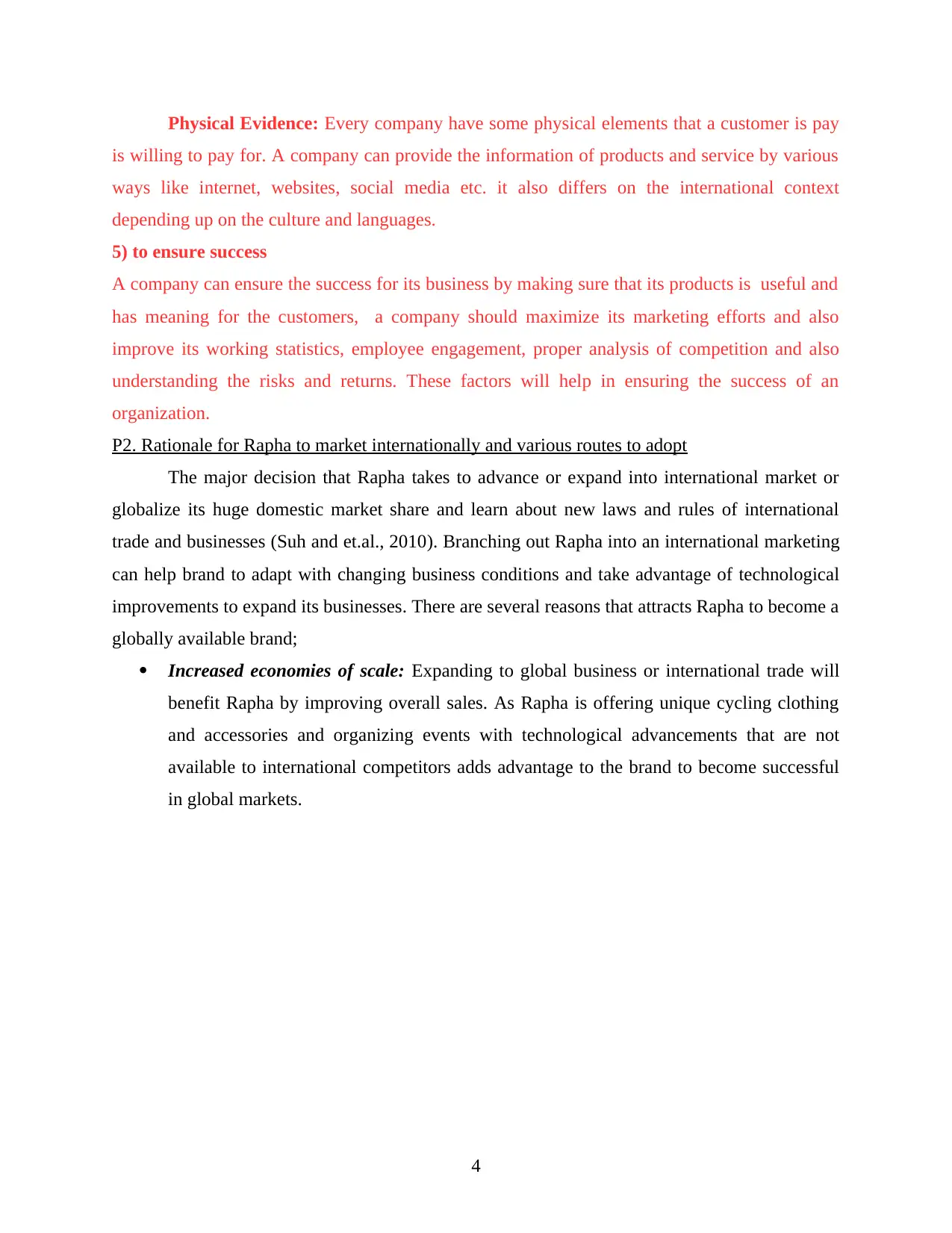
Physical Evidence: Every company have some physical elements that a customer is pay
is willing to pay for. A company can provide the information of products and service by various
ways like internet, websites, social media etc. it also differs on the international context
depending up on the culture and languages.
5) to ensure success
A company can ensure the success for its business by making sure that its products is useful and
has meaning for the customers, a company should maximize its marketing efforts and also
improve its working statistics, employee engagement, proper analysis of competition and also
understanding the risks and returns. These factors will help in ensuring the success of an
organization.
P2. Rationale for Rapha to market internationally and various routes to adopt
The major decision that Rapha takes to advance or expand into international market or
globalize its huge domestic market share and learn about new laws and rules of international
trade and businesses (Suh and et.al., 2010). Branching out Rapha into an international marketing
can help brand to adapt with changing business conditions and take advantage of technological
improvements to expand its businesses. There are several reasons that attracts Rapha to become a
globally available brand;
Increased economies of scale: Expanding to global business or international trade will
benefit Rapha by improving overall sales. As Rapha is offering unique cycling clothing
and accessories and organizing events with technological advancements that are not
available to international competitors adds advantage to the brand to become successful
in global markets.
4
is willing to pay for. A company can provide the information of products and service by various
ways like internet, websites, social media etc. it also differs on the international context
depending up on the culture and languages.
5) to ensure success
A company can ensure the success for its business by making sure that its products is useful and
has meaning for the customers, a company should maximize its marketing efforts and also
improve its working statistics, employee engagement, proper analysis of competition and also
understanding the risks and returns. These factors will help in ensuring the success of an
organization.
P2. Rationale for Rapha to market internationally and various routes to adopt
The major decision that Rapha takes to advance or expand into international market or
globalize its huge domestic market share and learn about new laws and rules of international
trade and businesses (Suh and et.al., 2010). Branching out Rapha into an international marketing
can help brand to adapt with changing business conditions and take advantage of technological
improvements to expand its businesses. There are several reasons that attracts Rapha to become a
globally available brand;
Increased economies of scale: Expanding to global business or international trade will
benefit Rapha by improving overall sales. As Rapha is offering unique cycling clothing
and accessories and organizing events with technological advancements that are not
available to international competitors adds advantage to the brand to become successful
in global markets.
4
⊘ This is a preview!⊘
Do you want full access?
Subscribe today to unlock all pages.

Trusted by 1+ million students worldwide
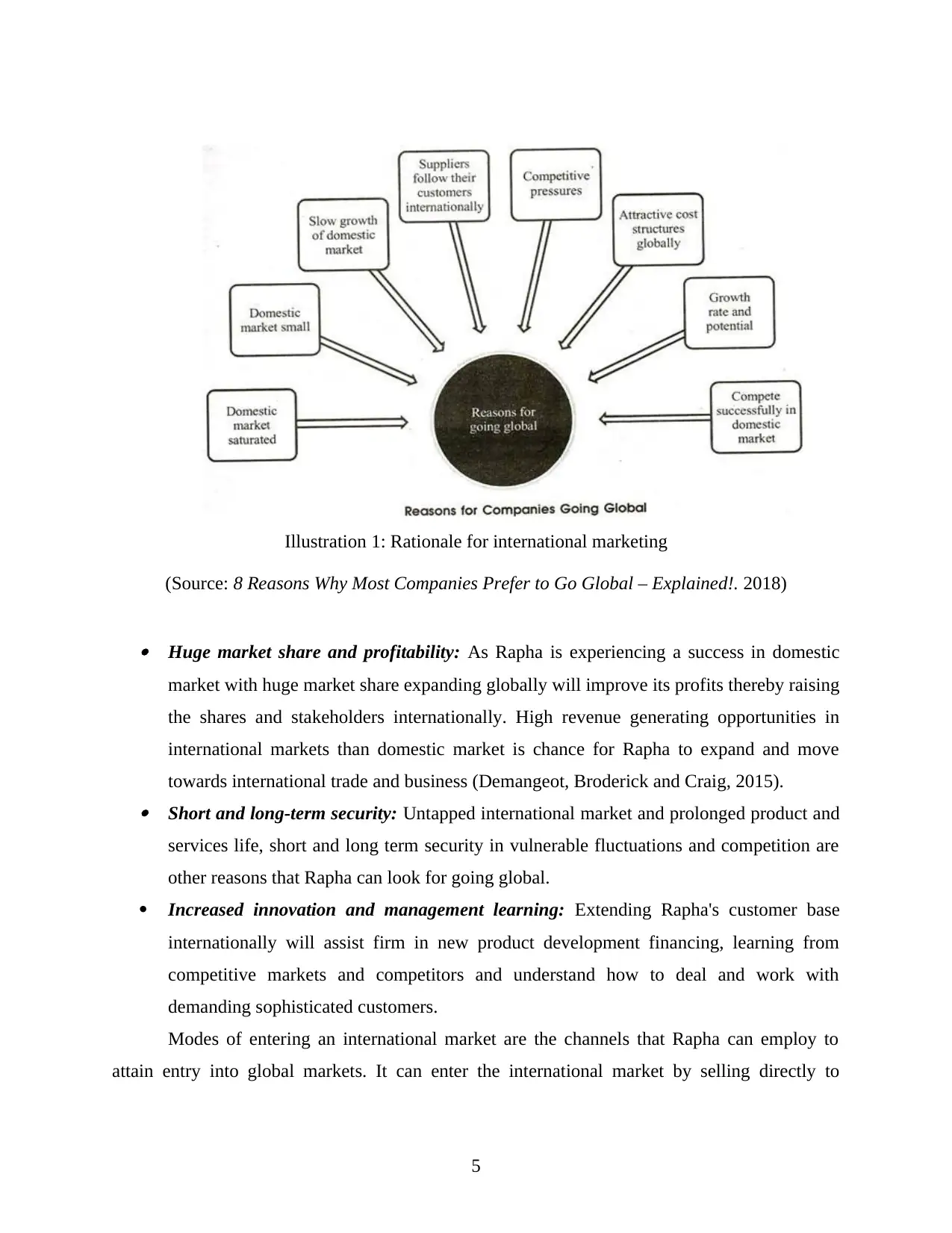
Huge market share and profitability: As Rapha is experiencing a success in domestic
market with huge market share expanding globally will improve its profits thereby raising
the shares and stakeholders internationally. High revenue generating opportunities in
international markets than domestic market is chance for Rapha to expand and move
towards international trade and business (Demangeot, Broderick and Craig, 2015). Short and long-term security: Untapped international market and prolonged product and
services life, short and long term security in vulnerable fluctuations and competition are
other reasons that Rapha can look for going global.
Increased innovation and management learning: Extending Rapha's customer base
internationally will assist firm in new product development financing, learning from
competitive markets and competitors and understand how to deal and work with
demanding sophisticated customers.
Modes of entering an international market are the channels that Rapha can employ to
attain entry into global markets. It can enter the international market by selling directly to
5
Illustration 1: Rationale for international marketing
(Source: 8 Reasons Why Most Companies Prefer to Go Global – Explained!. 2018)
market with huge market share expanding globally will improve its profits thereby raising
the shares and stakeholders internationally. High revenue generating opportunities in
international markets than domestic market is chance for Rapha to expand and move
towards international trade and business (Demangeot, Broderick and Craig, 2015). Short and long-term security: Untapped international market and prolonged product and
services life, short and long term security in vulnerable fluctuations and competition are
other reasons that Rapha can look for going global.
Increased innovation and management learning: Extending Rapha's customer base
internationally will assist firm in new product development financing, learning from
competitive markets and competitors and understand how to deal and work with
demanding sophisticated customers.
Modes of entering an international market are the channels that Rapha can employ to
attain entry into global markets. It can enter the international market by selling directly to
5
Illustration 1: Rationale for international marketing
(Source: 8 Reasons Why Most Companies Prefer to Go Global – Explained!. 2018)
Paraphrase This Document
Need a fresh take? Get an instant paraphrase of this document with our AI Paraphraser
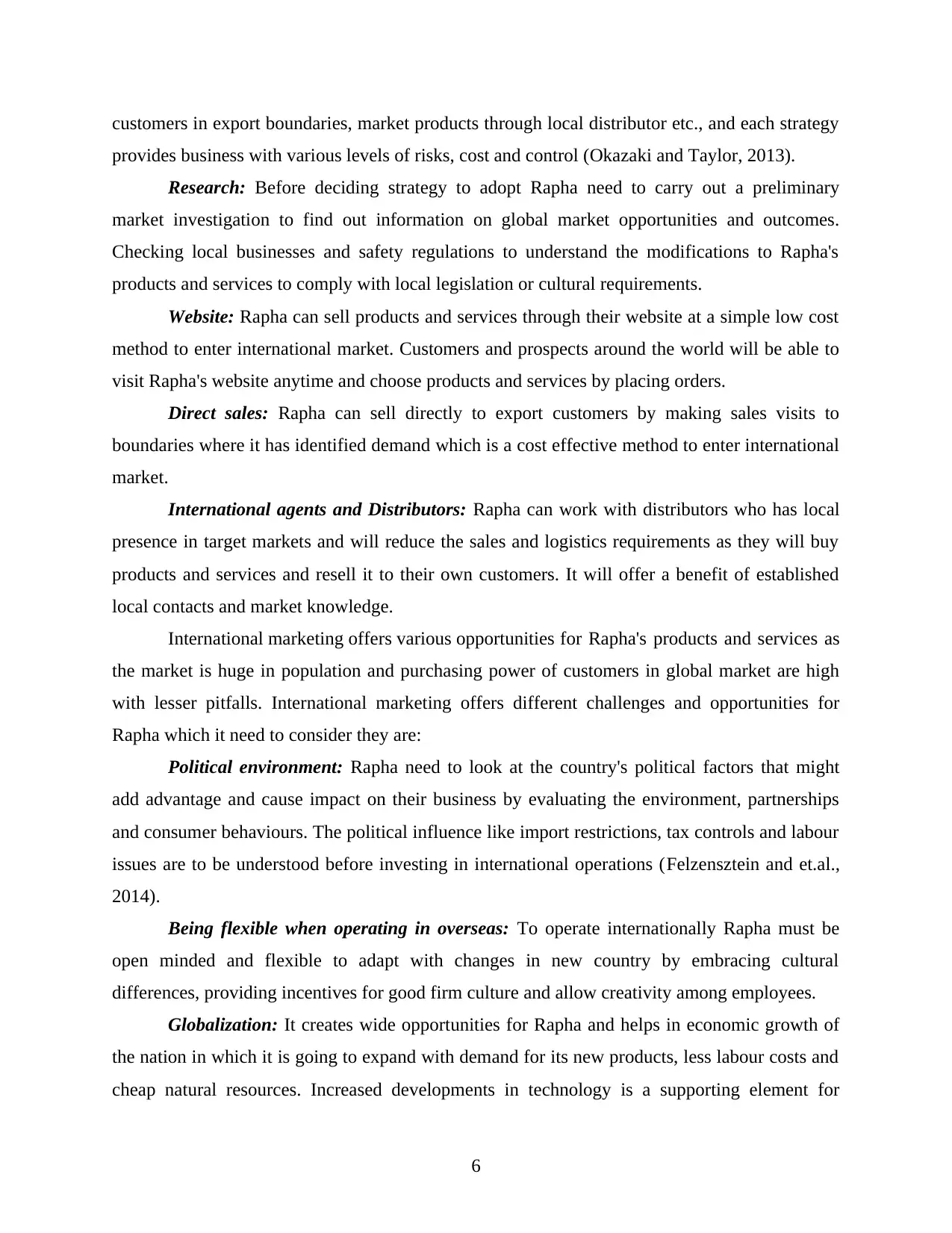
customers in export boundaries, market products through local distributor etc., and each strategy
provides business with various levels of risks, cost and control (Okazaki and Taylor, 2013).
Research: Before deciding strategy to adopt Rapha need to carry out a preliminary
market investigation to find out information on global market opportunities and outcomes.
Checking local businesses and safety regulations to understand the modifications to Rapha's
products and services to comply with local legislation or cultural requirements.
Website: Rapha can sell products and services through their website at a simple low cost
method to enter international market. Customers and prospects around the world will be able to
visit Rapha's website anytime and choose products and services by placing orders.
Direct sales: Rapha can sell directly to export customers by making sales visits to
boundaries where it has identified demand which is a cost effective method to enter international
market.
International agents and Distributors: Rapha can work with distributors who has local
presence in target markets and will reduce the sales and logistics requirements as they will buy
products and services and resell it to their own customers. It will offer a benefit of established
local contacts and market knowledge.
International marketing offers various opportunities for Rapha's products and services as
the market is huge in population and purchasing power of customers in global market are high
with lesser pitfalls. International marketing offers different challenges and opportunities for
Rapha which it need to consider they are:
Political environment: Rapha need to look at the country's political factors that might
add advantage and cause impact on their business by evaluating the environment, partnerships
and consumer behaviours. The political influence like import restrictions, tax controls and labour
issues are to be understood before investing in international operations (Felzensztein and et.al.,
2014).
Being flexible when operating in overseas: To operate internationally Rapha must be
open minded and flexible to adapt with changes in new country by embracing cultural
differences, providing incentives for good firm culture and allow creativity among employees.
Globalization: It creates wide opportunities for Rapha and helps in economic growth of
the nation in which it is going to expand with demand for its new products, less labour costs and
cheap natural resources. Increased developments in technology is a supporting element for
6
provides business with various levels of risks, cost and control (Okazaki and Taylor, 2013).
Research: Before deciding strategy to adopt Rapha need to carry out a preliminary
market investigation to find out information on global market opportunities and outcomes.
Checking local businesses and safety regulations to understand the modifications to Rapha's
products and services to comply with local legislation or cultural requirements.
Website: Rapha can sell products and services through their website at a simple low cost
method to enter international market. Customers and prospects around the world will be able to
visit Rapha's website anytime and choose products and services by placing orders.
Direct sales: Rapha can sell directly to export customers by making sales visits to
boundaries where it has identified demand which is a cost effective method to enter international
market.
International agents and Distributors: Rapha can work with distributors who has local
presence in target markets and will reduce the sales and logistics requirements as they will buy
products and services and resell it to their own customers. It will offer a benefit of established
local contacts and market knowledge.
International marketing offers various opportunities for Rapha's products and services as
the market is huge in population and purchasing power of customers in global market are high
with lesser pitfalls. International marketing offers different challenges and opportunities for
Rapha which it need to consider they are:
Political environment: Rapha need to look at the country's political factors that might
add advantage and cause impact on their business by evaluating the environment, partnerships
and consumer behaviours. The political influence like import restrictions, tax controls and labour
issues are to be understood before investing in international operations (Felzensztein and et.al.,
2014).
Being flexible when operating in overseas: To operate internationally Rapha must be
open minded and flexible to adapt with changes in new country by embracing cultural
differences, providing incentives for good firm culture and allow creativity among employees.
Globalization: It creates wide opportunities for Rapha and helps in economic growth of
the nation in which it is going to expand with demand for its new products, less labour costs and
cheap natural resources. Increased developments in technology is a supporting element for
6
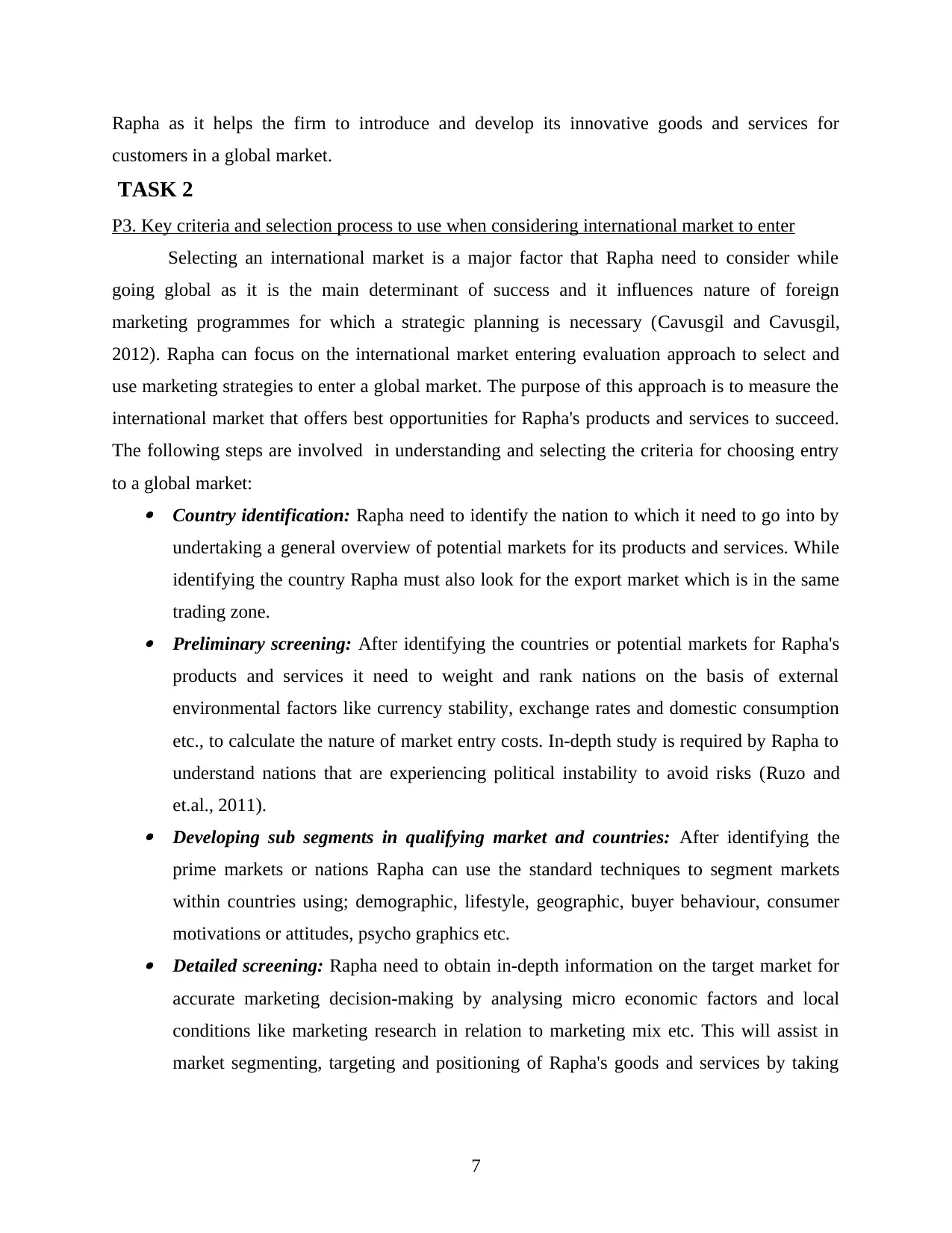
Rapha as it helps the firm to introduce and develop its innovative goods and services for
customers in a global market.
TASK 2
P3. Key criteria and selection process to use when considering international market to enter
Selecting an international market is a major factor that Rapha need to consider while
going global as it is the main determinant of success and it influences nature of foreign
marketing programmes for which a strategic planning is necessary (Cavusgil and Cavusgil,
2012). Rapha can focus on the international market entering evaluation approach to select and
use marketing strategies to enter a global market. The purpose of this approach is to measure the
international market that offers best opportunities for Rapha's products and services to succeed.
The following steps are involved in understanding and selecting the criteria for choosing entry
to a global market: Country identification: Rapha need to identify the nation to which it need to go into by
undertaking a general overview of potential markets for its products and services. While
identifying the country Rapha must also look for the export market which is in the same
trading zone. Preliminary screening: After identifying the countries or potential markets for Rapha's
products and services it need to weight and rank nations on the basis of external
environmental factors like currency stability, exchange rates and domestic consumption
etc., to calculate the nature of market entry costs. In-depth study is required by Rapha to
understand nations that are experiencing political instability to avoid risks (Ruzo and
et.al., 2011). Developing sub segments in qualifying market and countries: After identifying the
prime markets or nations Rapha can use the standard techniques to segment markets
within countries using; demographic, lifestyle, geographic, buyer behaviour, consumer
motivations or attitudes, psycho graphics etc. Detailed screening: Rapha need to obtain in-depth information on the target market for
accurate marketing decision-making by analysing micro economic factors and local
conditions like marketing research in relation to marketing mix etc. This will assist in
market segmenting, targeting and positioning of Rapha's goods and services by taking
7
customers in a global market.
TASK 2
P3. Key criteria and selection process to use when considering international market to enter
Selecting an international market is a major factor that Rapha need to consider while
going global as it is the main determinant of success and it influences nature of foreign
marketing programmes for which a strategic planning is necessary (Cavusgil and Cavusgil,
2012). Rapha can focus on the international market entering evaluation approach to select and
use marketing strategies to enter a global market. The purpose of this approach is to measure the
international market that offers best opportunities for Rapha's products and services to succeed.
The following steps are involved in understanding and selecting the criteria for choosing entry
to a global market: Country identification: Rapha need to identify the nation to which it need to go into by
undertaking a general overview of potential markets for its products and services. While
identifying the country Rapha must also look for the export market which is in the same
trading zone. Preliminary screening: After identifying the countries or potential markets for Rapha's
products and services it need to weight and rank nations on the basis of external
environmental factors like currency stability, exchange rates and domestic consumption
etc., to calculate the nature of market entry costs. In-depth study is required by Rapha to
understand nations that are experiencing political instability to avoid risks (Ruzo and
et.al., 2011). Developing sub segments in qualifying market and countries: After identifying the
prime markets or nations Rapha can use the standard techniques to segment markets
within countries using; demographic, lifestyle, geographic, buyer behaviour, consumer
motivations or attitudes, psycho graphics etc. Detailed screening: Rapha need to obtain in-depth information on the target market for
accurate marketing decision-making by analysing micro economic factors and local
conditions like marketing research in relation to marketing mix etc. This will assist in
market segmenting, targeting and positioning of Rapha's goods and services by taking
7
⊘ This is a preview!⊘
Do you want full access?
Subscribe today to unlock all pages.

Trusted by 1+ million students worldwide
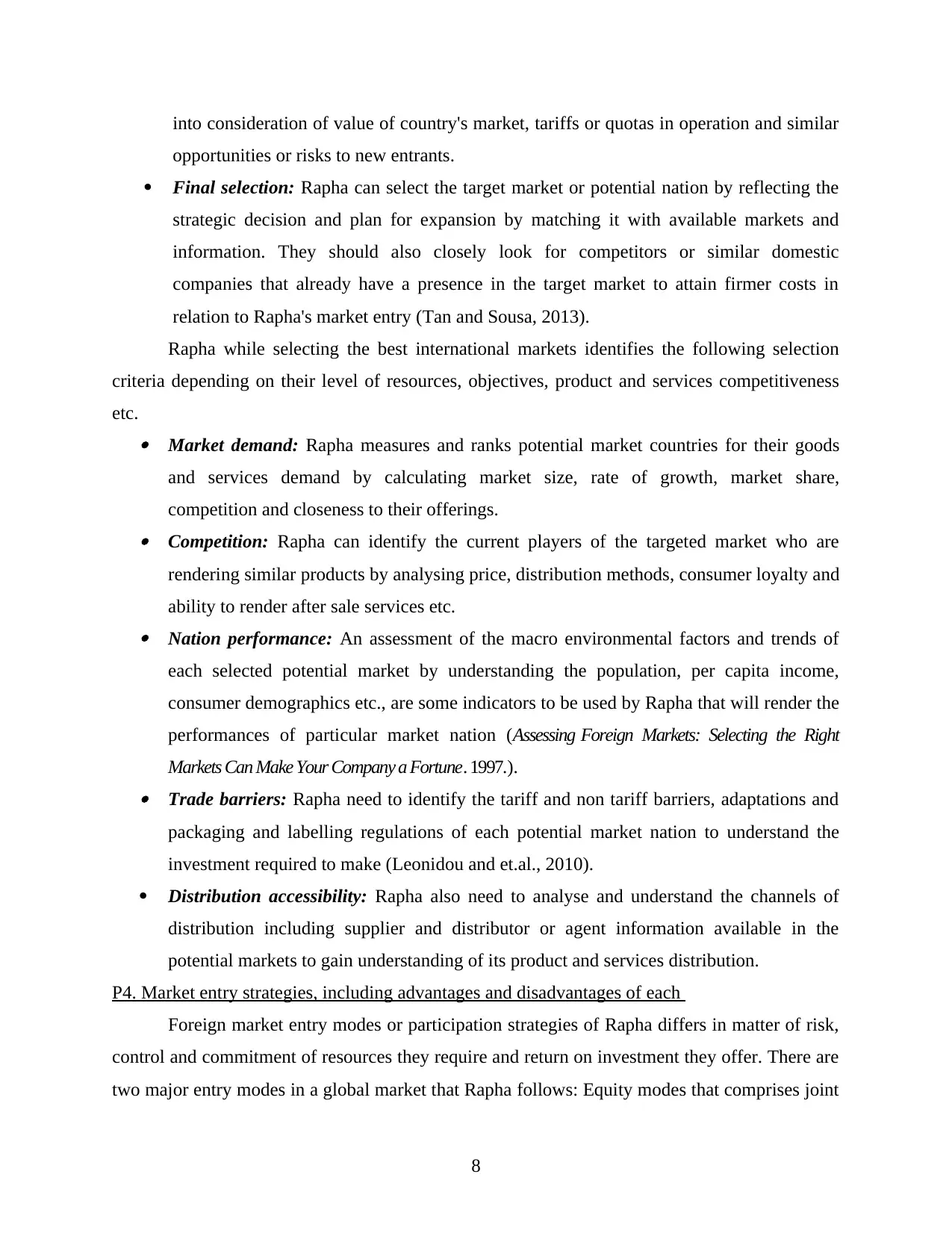
into consideration of value of country's market, tariffs or quotas in operation and similar
opportunities or risks to new entrants.
Final selection: Rapha can select the target market or potential nation by reflecting the
strategic decision and plan for expansion by matching it with available markets and
information. They should also closely look for competitors or similar domestic
companies that already have a presence in the target market to attain firmer costs in
relation to Rapha's market entry (Tan and Sousa, 2013).
Rapha while selecting the best international markets identifies the following selection
criteria depending on their level of resources, objectives, product and services competitiveness
etc. Market demand: Rapha measures and ranks potential market countries for their goods
and services demand by calculating market size, rate of growth, market share,
competition and closeness to their offerings. Competition: Rapha can identify the current players of the targeted market who are
rendering similar products by analysing price, distribution methods, consumer loyalty and
ability to render after sale services etc. Nation performance: An assessment of the macro environmental factors and trends of
each selected potential market by understanding the population, per capita income,
consumer demographics etc., are some indicators to be used by Rapha that will render the
performances of particular market nation (Assessing Foreign Markets: Selecting the Right
Markets Can Make Your Company a Fortune. 1997.). Trade barriers: Rapha need to identify the tariff and non tariff barriers, adaptations and
packaging and labelling regulations of each potential market nation to understand the
investment required to make (Leonidou and et.al., 2010).
Distribution accessibility: Rapha also need to analyse and understand the channels of
distribution including supplier and distributor or agent information available in the
potential markets to gain understanding of its product and services distribution.
P4. Market entry strategies, including advantages and disadvantages of each
Foreign market entry modes or participation strategies of Rapha differs in matter of risk,
control and commitment of resources they require and return on investment they offer. There are
two major entry modes in a global market that Rapha follows: Equity modes that comprises joint
8
opportunities or risks to new entrants.
Final selection: Rapha can select the target market or potential nation by reflecting the
strategic decision and plan for expansion by matching it with available markets and
information. They should also closely look for competitors or similar domestic
companies that already have a presence in the target market to attain firmer costs in
relation to Rapha's market entry (Tan and Sousa, 2013).
Rapha while selecting the best international markets identifies the following selection
criteria depending on their level of resources, objectives, product and services competitiveness
etc. Market demand: Rapha measures and ranks potential market countries for their goods
and services demand by calculating market size, rate of growth, market share,
competition and closeness to their offerings. Competition: Rapha can identify the current players of the targeted market who are
rendering similar products by analysing price, distribution methods, consumer loyalty and
ability to render after sale services etc. Nation performance: An assessment of the macro environmental factors and trends of
each selected potential market by understanding the population, per capita income,
consumer demographics etc., are some indicators to be used by Rapha that will render the
performances of particular market nation (Assessing Foreign Markets: Selecting the Right
Markets Can Make Your Company a Fortune. 1997.). Trade barriers: Rapha need to identify the tariff and non tariff barriers, adaptations and
packaging and labelling regulations of each potential market nation to understand the
investment required to make (Leonidou and et.al., 2010).
Distribution accessibility: Rapha also need to analyse and understand the channels of
distribution including supplier and distributor or agent information available in the
potential markets to gain understanding of its product and services distribution.
P4. Market entry strategies, including advantages and disadvantages of each
Foreign market entry modes or participation strategies of Rapha differs in matter of risk,
control and commitment of resources they require and return on investment they offer. There are
two major entry modes in a global market that Rapha follows: Equity modes that comprises joint
8
Paraphrase This Document
Need a fresh take? Get an instant paraphrase of this document with our AI Paraphraser
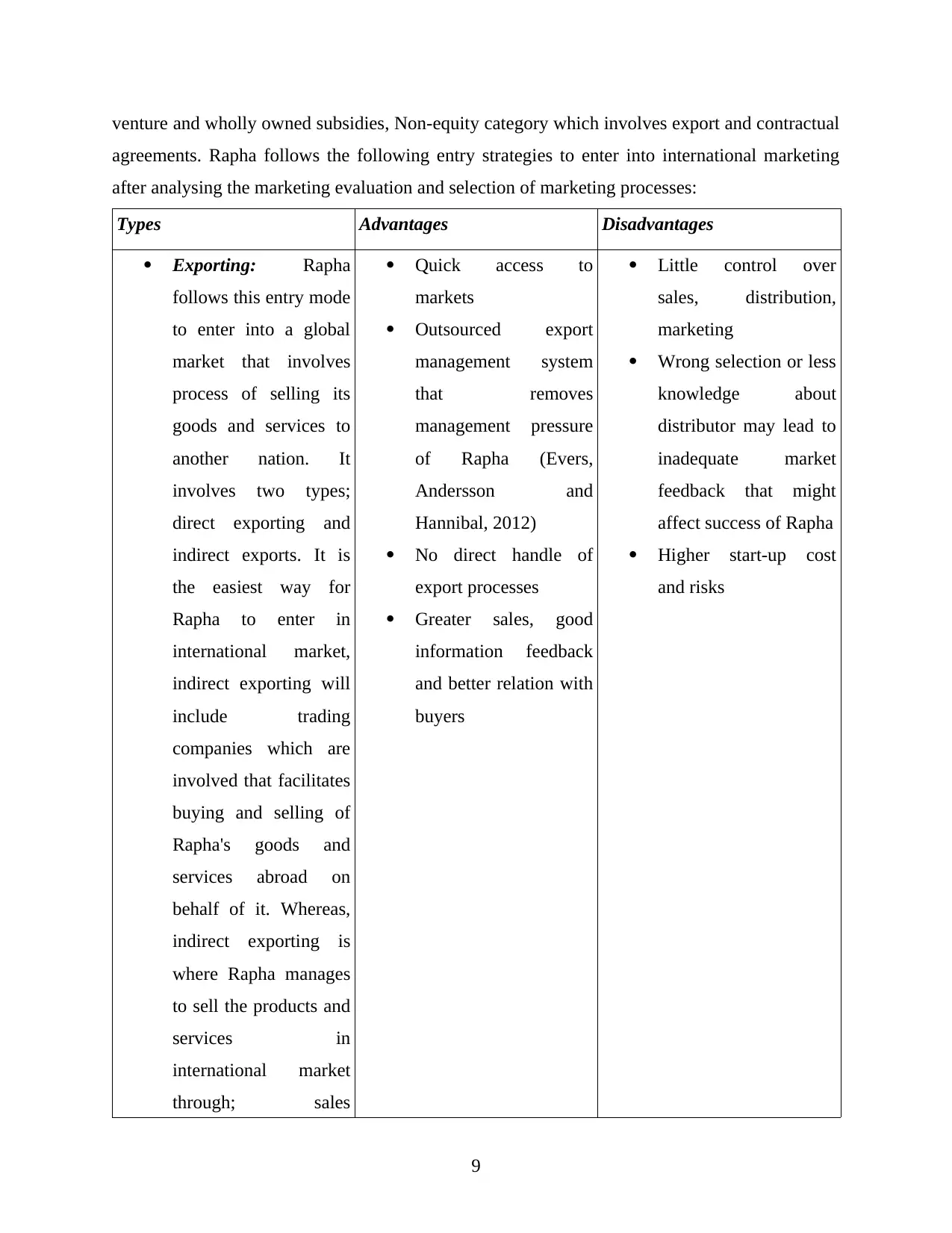
venture and wholly owned subsidies, Non-equity category which involves export and contractual
agreements. Rapha follows the following entry strategies to enter into international marketing
after analysing the marketing evaluation and selection of marketing processes:
Types Advantages Disadvantages
Exporting: Rapha
follows this entry mode
to enter into a global
market that involves
process of selling its
goods and services to
another nation. It
involves two types;
direct exporting and
indirect exports. It is
the easiest way for
Rapha to enter in
international market,
indirect exporting will
include trading
companies which are
involved that facilitates
buying and selling of
Rapha's goods and
services abroad on
behalf of it. Whereas,
indirect exporting is
where Rapha manages
to sell the products and
services in
international market
through; sales
Quick access to
markets
Outsourced export
management system
that removes
management pressure
of Rapha (Evers,
Andersson and
Hannibal, 2012)
No direct handle of
export processes
Greater sales, good
information feedback
and better relation with
buyers
Little control over
sales, distribution,
marketing
Wrong selection or less
knowledge about
distributor may lead to
inadequate market
feedback that might
affect success of Rapha
Higher start-up cost
and risks
9
agreements. Rapha follows the following entry strategies to enter into international marketing
after analysing the marketing evaluation and selection of marketing processes:
Types Advantages Disadvantages
Exporting: Rapha
follows this entry mode
to enter into a global
market that involves
process of selling its
goods and services to
another nation. It
involves two types;
direct exporting and
indirect exports. It is
the easiest way for
Rapha to enter in
international market,
indirect exporting will
include trading
companies which are
involved that facilitates
buying and selling of
Rapha's goods and
services abroad on
behalf of it. Whereas,
indirect exporting is
where Rapha manages
to sell the products and
services in
international market
through; sales
Quick access to
markets
Outsourced export
management system
that removes
management pressure
of Rapha (Evers,
Andersson and
Hannibal, 2012)
No direct handle of
export processes
Greater sales, good
information feedback
and better relation with
buyers
Little control over
sales, distribution,
marketing
Wrong selection or less
knowledge about
distributor may lead to
inadequate market
feedback that might
affect success of Rapha
Higher start-up cost
and risks
9
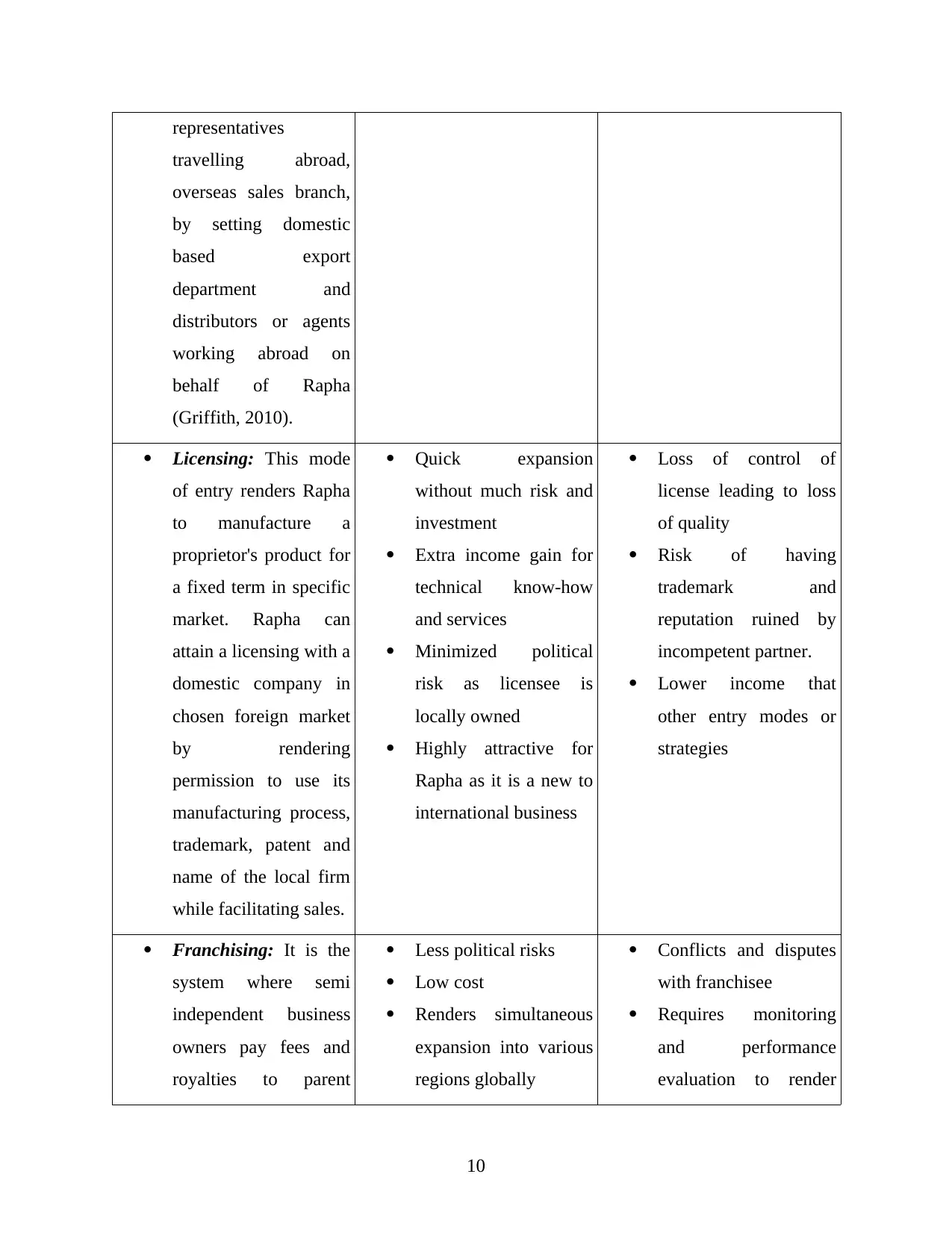
representatives
travelling abroad,
overseas sales branch,
by setting domestic
based export
department and
distributors or agents
working abroad on
behalf of Rapha
(Griffith, 2010).
Licensing: This mode
of entry renders Rapha
to manufacture a
proprietor's product for
a fixed term in specific
market. Rapha can
attain a licensing with a
domestic company in
chosen foreign market
by rendering
permission to use its
manufacturing process,
trademark, patent and
name of the local firm
while facilitating sales.
Quick expansion
without much risk and
investment
Extra income gain for
technical know-how
and services
Minimized political
risk as licensee is
locally owned
Highly attractive for
Rapha as it is a new to
international business
Loss of control of
license leading to loss
of quality
Risk of having
trademark and
reputation ruined by
incompetent partner.
Lower income that
other entry modes or
strategies
Franchising: It is the
system where semi
independent business
owners pay fees and
royalties to parent
Less political risks
Low cost
Renders simultaneous
expansion into various
regions globally
Conflicts and disputes
with franchisee
Requires monitoring
and performance
evaluation to render
10
travelling abroad,
overseas sales branch,
by setting domestic
based export
department and
distributors or agents
working abroad on
behalf of Rapha
(Griffith, 2010).
Licensing: This mode
of entry renders Rapha
to manufacture a
proprietor's product for
a fixed term in specific
market. Rapha can
attain a licensing with a
domestic company in
chosen foreign market
by rendering
permission to use its
manufacturing process,
trademark, patent and
name of the local firm
while facilitating sales.
Quick expansion
without much risk and
investment
Extra income gain for
technical know-how
and services
Minimized political
risk as licensee is
locally owned
Highly attractive for
Rapha as it is a new to
international business
Loss of control of
license leading to loss
of quality
Risk of having
trademark and
reputation ruined by
incompetent partner.
Lower income that
other entry modes or
strategies
Franchising: It is the
system where semi
independent business
owners pay fees and
royalties to parent
Less political risks
Low cost
Renders simultaneous
expansion into various
regions globally
Conflicts and disputes
with franchisee
Requires monitoring
and performance
evaluation to render
10
⊘ This is a preview!⊘
Do you want full access?
Subscribe today to unlock all pages.

Trusted by 1+ million students worldwide
1 out of 22
Related Documents
Your All-in-One AI-Powered Toolkit for Academic Success.
+13062052269
info@desklib.com
Available 24*7 on WhatsApp / Email
![[object Object]](/_next/static/media/star-bottom.7253800d.svg)
Unlock your academic potential
Copyright © 2020–2025 A2Z Services. All Rights Reserved. Developed and managed by ZUCOL.



